|
●Datable "Notre Dame" Conductus: New
Historical Observations on Style and
Technique4
Musical Designs
The evidence illustrated by the poems in the datable repertory may appear informative for the history of Notre Dame conductus, but the testimony provided by its music, some of which has already surfaced above, is even more profitable.
Although Sanders (1985b) provided a valuable initial foray into this topic,
an investigation of the changes in musical style throughout the entire
datable Notre Dame corpus still remains to be accomplished. Sanders's results,
as he himself admitted, were especially limited by the fact that he did
not incorporate monophonic pieces into his evaluations.39 Their inclusion,
however, is indispensable for a balanced overview. Therefore, in an effort
to expand his findings and to reinforce his depictions of chronological
trends, both monophonic and polyphonic datable conductus are examined here.
datableレパートリーの詩によって説明されたevidenceは、ノートルダムconductusの歴史に対して、有益であるように思える。しかし、その音楽によって見出された証言は、すでに述べたように、さらに有益なものである。
Sanders は、この話題に関して最初の価値ある調査結果を示したが、全体のdatableなノートルダム作品群の音楽形式における変化の調査は、まだ完全には達成されてはいない。Sandersの調査結果は、彼自身はそれで満足するかもしれないが、彼が自身の調査への評価においてモノフォニックな作品を含めなかったということにより、限定的なのである。しかしながら、モノフォニーを調査に含めることは、バランスが取れた見方のためには必須のことである。それゆえ、彼の発見をより拡張するために、そして彼の時系列的傾向の描写をより補うために、ここでは、モノフォニーとポリフォニーの両方のdatable
conductusを調査してみたいと思う。
Monophony
Since so
much of the general inquiry into Notre Dame music has focused on
polyphony, the position of the monophonic pieces in the repertoire has
tended to remain obscure. This has also been the case in earlier research
on the datable repertory, possibly because monophonic works lack so many
of the clues that polyphony suggests for charting historical change.
Although in their most
general features they do conform to the historical trends demonstrated by
the datable polyphonic conductus, evidence for
rhythmic interpretation, economy of melodic material, and an increasing
clarity and complexity of formal musical structures are all absent or
figure less prominently in the monophonic pieces. Moreover, the stylistic
overview of the one-part conductus shows that they exhibit less obvious
enrichment after the turn of the century than do contemporaneous
polyphonic
works.
ノートルダム音楽への一般的調査以降、モノフォニー作品の地位はあいまいに残される傾向にあった。こうしたことは、datableレパートリーの初期調査でみられたことであり、おそらくそれは、モノフォニー作品が、ポリフォニー作品が歴史的変化を記録するような多くの糸口を欠いているためである。
一般的特徴として、そうした調査結果は、datable
polyphonic
conductusによって証明された歴史的傾向にはかなっていたが、リズム解釈の証拠、旋律の素材の節約と音楽構造の複雑さは、ほとんどのモノフォニー作品では、存在しないか、顕著ではない。さらに、単声conductusの形式調査によって、世紀の変わり目以降、それが、同時代のポリフォニー作品よりもあいまいな装飾しかされていないことが示されたのである。
Within
the datable monophonic corpus, however, a distinctive early convention
does arise in several conductus that present musical designs associated
especially with the vernacular songs of the trouveres. Such pieces are
characterized by the complete absence of melismatic sections, a generally
syllabic or at most lightly ornamented setting of music to text, and a
structure that presents a repetition of the phrases for the opening two or
three poetic lines.
The bipartite AA/B formal design that is
evident in these works has long been recognized as a familiar element of
medieval vernacular song. As early as the first decade of the fourteenth
century, Dante alluded to the practice in his De vulgari
eloquentia, an unfinished treatise on vernacular poetry and song
that often features excerpts from
the texts of troubadour and trouvere chansons as illustrative
material. In a chapter dealing with the
composition of the stanzas of a song (cantio), Dante relates the
most common formal elements that are found in the music of such
works
datableなモノフォニー体系においてはしかしながら、trouvereの世俗歌と特に関連した音楽的デザインを持ついくつかのconductusについて、区別すべき初期慣例が生じている。メリスマの欠如によって特徴づけられるそうしたconductusは、一般的にはシラビックであり、あるいはもっとも簡単に飾られた音楽設定になっており、最初の2〜3の詩の行に対するフレーズが繰り返しを持つような構造になっている。
AAB形式は、中世の世俗歌の中では、おなじみの要素として以前より認められてきた。14世紀初頭の早い時期に、ダンテは「俗語論(De
vulgari eloquentia)」や、例示素材として抜粋したのtroubadourとtrouvereの
chansonsのテキストを持つ世俗詩と世俗歌についての未完成の論文中において実践について言及している。歌(cantio)の音節の作曲を扱う章においては、Danteは、こうした作品中の音楽に見出されるもっとも一般的な要素について扱っている。
We say, therefore, that every stanza is composed in order to receive a
specific melody; but there are different ways of doing this.
For there are some [stanzas] that proceed all the way through to the end
by means of a through-composed melody [oda continuata] - that is without
a repetition of any phrase and without diesis.
And we define dies is as a progression [within a song] that turns from one melody to another, which when we speak in the vernacular, we call a volta (turn) ....
On the other hand, there are certain [stanzas] that do admit diesis; and
there can be no diesis according to the way it is defined here, unless
a melody undergo repetition either before, after, or on either side of
the diesis.
If the repetition is made before the diesis, we say that the stanza has pedes (feet); and it is proper that it should have two, although now and then three appear, albeit rarely. If the repetition occurs after the diesis, then we say that the stanza has versus (verses). Ifthere is no repetition before [the diesis], we say that the stanza has a frons (front); if there is none afterwards, we say that it has a sirma, or cauda (tail).4o
したがって、すべてのスタンザは特定のメロディーを受け取るために構成されていると言えよう。しかし、これを行うにはさまざまな方法があります。
なぜなら、通作歌曲形式のメロディー[oda continuata]によって最後まで続くいくつかの[スタンザ]があるからである。そこでは、フレーズの繰り返しや diesisはありません。
そして、私たちは、あるメロディーから別のメロディーに変わる[曲内の]進行としてdiesisを定義します。これは、私たちが母語で話すとき、volta (turn) と呼びます....
一方、diesisを認める特定の[スタンザ]があります。そして、メロディーがdiesisの前、後、で繰り返されなければ、ここで定義されている方法に従ってのdiesisはあり得ない。
繰り返しがdiesisの前に行われる場合、スタンザにはpedes (feet); があると言います。そして、時々3つが示されますが、2つあるのが適切です。繰り返しがdiesisの後に発生する場合、スタンザにはversus (verses).があると言います。 [diesis]の前に繰り返しがない場合、スタンザにはfrons (front); があると言います。後で何もない場合は、sirma, or cauda (tail)があると言います。
Dante's observations
may be paraphrased a little more readily by using the alphabetical
designations common to musical analysis: if the form of a song can be
represented by AAB, it is composed of two pedes and a cauda;41 if
by ABB, it features a frons and two versus. Should a work divide in the
manner AABB, then it has both pedes and versus. If, however, the piece is
through-composed, it has none of these four
elements.
ダンテの考察は、音楽分析においては一般的な、アルファベット的デザインの利用によって、少しパラフレーズされるかもしれない。もしも歌の形式がAABで表されるのなら、それは二つの
pedes と一つの caudaによって作られることになる。もしもABBであるのなら、それは1つのfrons と2つの
versusで特徴づけられる。もしも作品がAABBで分けられるなら、pedesと
versus両方を持つことになる。しかし作品が通作されるのであれば、こうした4つの要素は何もなくなることになる。
The scheme of the
pedes-pIus-cauda (AAB) plan described by Dante and designated here as
the cantio form is one of the most common designs in the entire
body of medieval song. According to Spanke, the cantio form is
first observable in the cansos of the earliest troubadours,
and soon spread to other lyrics. This same form so dominated Latin song
written in the twelfth and thirteenth centuries that it is estimated that
half the surviving corpus, both in the Notre Dame repertory and elsewhere,
uses this structural pattern.42
ダンテによって記述され、そして、cantio形式でデザインされたAAB(Relationships between the Twelfth-Century Aquitanian Polyphonic Versus and Two-Part Conductus Repertoriesp67参照)におけるpedes+caudaのスキームは、中世歌の全体においてはもっとも共通したデザインの一つであった。Spankeによれば、cantio
形式は、最初は初期のtroubadourのcansosに見出される。そしてまもなく、他の抒情詩にも広がっていった。この同じ形式は、12,13世紀に書かれたラテン語歌においても優勢であり、両者ともに、ノートルダムレパートリーやその他の部分においても、この構造が使われた。
The
confluence of the medieval vernacular chanson and the Notre Dame conductus
is therefore especially evident in the five datable syllabic43 works that
present cantio forms (see table 9). Their formal structures are
remarkably consistent. Four of the five specimens within this body of
pieces confine their opening section (the two pedes) to the first four
poetic lines. Here the musical phrases of the third and fourth lines echo
the first and second, producing the pattern a-b a-b, or on a larger scale
AA.
Likewise, the length of the succeeding cauda (the B section
of the cantio form) in all but two of these works happens to correspond
exactly with the two pedes in its number of lines; but it also may be
independent in length and structure, as in the nine-line cauda
segment of Venit Ihesus in propria (1187), or the three lines of
Pater sancte dictus Lotarius (1198), both with texts by Philip the
Chancellor. In addition, refrains may be present, as in Walter of
Chatillon's Dum medium silentium tenerent (1174). In two different
instances in the datable repertory, though, the cauda section exhibits a
repetition scheme of its own that signals the presence of Dante's versus.
A representative case of the use of both pedes and versus in a
conductus can be seen in Pater sancte, offered as example1, which,
significantly, is a contrafact of the trouvere chanson Douce dame grez
et graces vous rent by Gace Brule.44 In this piece the customary pair
of two-line pedes (AB AB) is followed by two versus of one line each (CC'
), the first member of which closes on the final pitch of the mode (g),
the second on its upper third (b). This "open" segment is then completed
by a relatively ornate final phrase (D), which sets the last line of the
strophe and rounds off the composition by cadencing once again on the
final.
中世の世俗chansonとノートルダムconductusの合流は、それゆえ、cantio形式の5つのdatableなシラビックな作品において、特に明らかである(see
table
9)。こうした形式構造には、顕著な一貫性がみられる。5つの作品のうちの4つは、作品内において、オープニングセクション(ふたつのpedes)を最初の4つの詩行に制限している。ここでは、第3,4行の音楽フレーズは第1,2を反響し、a-b
a-b, あるいはより大規模な
A(ab)-A(ab)を作り出している。

同様に、引き続くcaudaの長さは、これら二つの作品を除けば、すべてにおいて、その行数において、二つのpedesに正確に呼応する。しかし、それは長さと構造において独立しているかもしれない。Venit
Ihesus in propria (1187)のcauda部分の9行、あるいはPater sancte dictus
Lotarius (1198)( both with texts by Philip the
Chancellor)の同じく3行のように。加えて、Walter of ChatillonのDum medium silentium
tenerentにおいては、refrainが存在しているかもしれない。datableレパートリーにおける二つの例において、cauda部位は、ダンテのversusの存在を示す、それ自身の繰り返しスキームを示している。
pedesとversusの両方を利用する代表例は、
Pater sancteにおいて見られる( example1)。この作品はGace BruleによるDouce dame
grez et graces vous rentのcontrafactaである。この作品においては、二つの行のpedesの慣習的なペア(AB
AB)
は、1行がそれぞれC,C'となる2つのversusによってフォローされる。最後の音高はソ音であり、次はその三度上のシ音である。この(Dの部分の)最後の”開かれた”なsegmentは、詩句の最後の行を設定し、最終的終止することによって曲を締める最後の華美なフレーズDとして終結する。
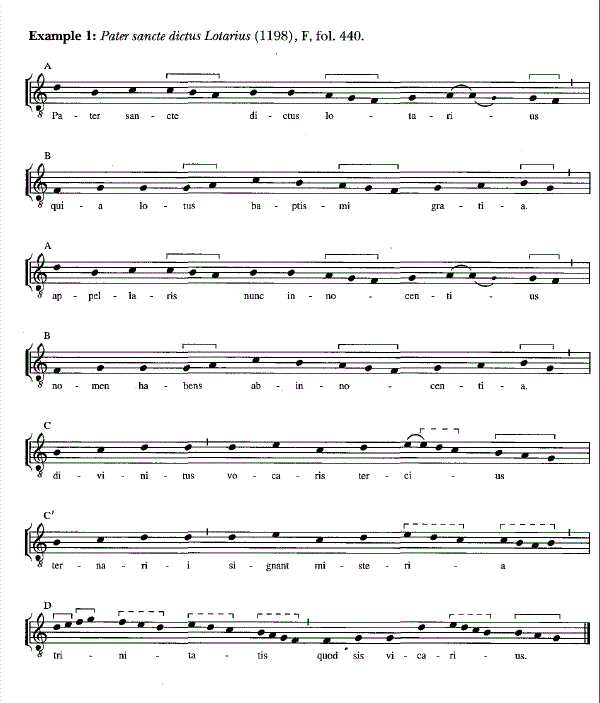
http://teca.bmlonline.it/ImageViewer/servlet/ImageViewer?idr=TECA0000342136#page/819/mode/1up
P405r
Besides
contrafacture, these cantio-form pieces exhibit additional affinities with
the trouvere corpus in their poetic forms. All are either strophic or
single stanzas that appear to be the only surviving members of an
originally multistrophic lyric.45 The single exception to this
characteristic is the 1181 Omnis in lacrimas, a sequence form whose
first stanzaic pair also diverges from the more usual two-line coupling of
pedes in the other datable conductus by admitting a three-line repetition
(see example
2).46
contrafactaは別として、こうしたcantio形式の作品は、詩の形式において、trouvere
の作品に対する親和性が示されている。すべては1詩句、1音節であり、もともとは多くの詩句を持つ抒情詩の生き残りたちであるからである。これらのうちでただひとつの例外はOmnis
in lacrimasで、最初の音節のペアが他のdatable
conductusのpedesの2つのカップリング(AB)とは異なり、3行での繰り返し(ABC)となっている。(see example
2)。
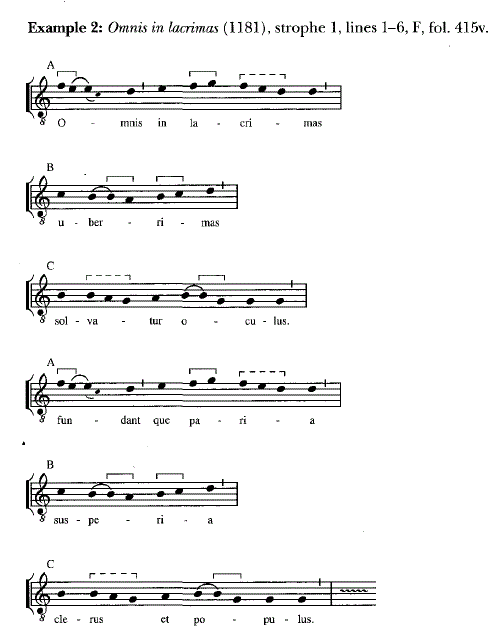 In considering the
historical significance of these compositions, it seems consequential that
all of these "trouvere-style" conductus predate the thirteenth century.
They range from the earliest datable work, In
Rama son at gemitus
(1164-1170), to Philip's Pater sanctefrom 1198. Though there are
indeed two later datable monophonic compositions that use the opening
repetition typical of trouvere chansons, these differ from the ones
considered here since they either contain extensive caudae, or are
prosulas―texts written to conductus caudae that have been dissociated from
their original setting.47
Hence, that part of the datable
repertory that most closely
resembles the vernacular songs of the trouveres
seems, significantly, to embrace a very early layer of compositions. This
assertion is strengthened by the predominance of strophic forms among the
relevant examples, as well as the presence of the single datable example
of an isosyllabic 10pp lyric in Pater sancte dictus Lotarius.
Philip the Chancellor's two earliest datable works are counted among the
pieces in this stratum, and the cantio form is also well
represented in the surviving music to several of the texts of his older
contemporary, Walter of Chatillon.48
こうした曲の歴史的重要性を考えると、こうした"trouvere-style"
conductusは、13世紀より先立っていたことように思える。その期間は、は、一番初期のdatable作品In Rama son at
gemitus (1164-1170)から、1198年の Philip'の Pater
sanctefromにまで及んでいる。最初の繰り返しにtrouvere
chansonを使った20年ほどあとのdatableなモノフォニー作品もあるが、これらはこれまで考えられてきた作品群とは異なっている。なぜなら、いずれも発達したcaudaを含み、オリジナル設定からはかけ離れたconductus
caudaに書かれたテキストを持つprosulaだからである。
trouvereの世俗歌に非常によく似ているdatableレパートリーのそうした一部は、非常に早期の作品群を包含しているように思える。こうした主張は、Pater
sancte dictus
Lotariusにおけるisosyllabicな10pp抒情詩のひとつのdatableな例の存在同様、相当する例における詩句形の優位性によって強められる。Philip
the
Chancellorの二つの最初期のdatableな作品はこうした部類の作品に数えられる。そして、cantio形式はまた同様に、彼よりもやや古い時代の人であるWalter
of Chatillonのいくつかのテキストに対する音楽にも認められる。
Unfortunately, no other formal melodic designs in the music of the datable
monophonic conductus appear as chronologically decisive as the trouvere-style
cantio form, nor are they easily classified. Other incidents of phrase
repetition do exist, but such cases either accommodate only a very few
examples, or else they are chronologically diverse and therefore not readily
indicative of stylistic trends.49
Similarly, those compositions that are through-composed on the strophic
level and those with occasional or unsystematic repetition of phrases
appear in the datable repertory soon after the cantio form and coexist with it.
The earliest such through‐composed strophes occur in the second and third
versicles of Omnis in
lacrimas, a conductus in sequence form from 1181, whose initial
strophic pair, as shown in example 2, features a cantio structure with a
pes of three lines.
不幸なことに、その他のdatable monophonic conductusの形式的なメロディのデザインは、時系列的には trouvere形式(cantio形式)には出現せず、簡単にそこに分類されることもなかった。フレーズを繰り返す他の事例は存在はしたが、そのようなケースはごくわずかな例にしか適合しないか、あるいは、それらは時系列的に多様であり、したがって、形式上の傾向を示すことは容易ではなかった。
同様に、ストロフィックレベルで作られたり、機会的あるいはフレーズの系統的ではない繰り返しを持つこうした作品が、datableなレパートリーにおいては、cantio形式のあとほどなく出現し、共存していくようになった。
このような最初期の通作詩句は、1181年からの、セクエンツィア形式のcondctusであるOmnis
in
lacrimasの第2,3versicleに出現する。この最初の詩句ストロフィックペアはexample2で示されたとおり、3行pesの構造を特徴としている。
Somewhat
more enlightening for the chronology of the datable monophonic conductus
is the noticeable change in style between the earliest syllabic works and
those later ones that contain melismatic sections. The rise of such caudae
in the monophonic repertory coincides almost exactly with their appearance
in the polyphonic conductus (Sanders 1985b: 505). Melismas are absent from
six of the seven earliest pieces in the datable corpus50 and first surface
as a component of the monophonic repertory in the lament Anglia
planctus itera from either 1186 or 1189. Already in this initial
appearance, short melismas or groups of ornate neumes not only introduce
each strophe, but occur throughout this richly embellished composition.
Their employment in strophe 2 is particularly sophisticated and indicates
that a high degree of fluency is already possible in this elaborate style.
In Anglia planctus, the presence of brief caudae not only imparts a
musical complexity to this piece that is missing in the trouvere-style
works profiled above, but also serves in this instance as a notable means
of delineating the structure of its text (see example
3).
datableなモノフォニーconductusを時系列で確認していくと、最初期のシラビックな作品とより後のメリスマを含む作品の間の注目すべき変化が現れてくる。モノフォニー作品のcaudaの台頭は、ほぼ正確に、ポリフォニーconductusのそれに一致する。メリスマはdatable作品において最初の7作品中6作品において欠如しており、そして、その最初のものはモノフォニー作品であるlamment
Anglia planctus itera from either 1186 or 1189の一部(strophe
2)に出現する。すでに最初のこの出現において、短いメリスマや装飾されたネウマグループは単にそれぞれの詩句を導くだけでなく、この豊かに飾られた作品全体にちりばめられるようになる。strophe
2(下譜)におけるこうしたメリスマの使い方は部分的には洗練されたものであり、この精巧なスタイルでは、高いレベルの流暢さがすでに可能であることを示している。Anglia
planctusにおいては、簡素なcaudaの存在は、すでに述べられたように、trouvere形式の作品では失われている音楽的複雑さを伝えるだけでなく、この例において、そのテキストの構造の輪郭を描く注目すべき手段として提示されている。
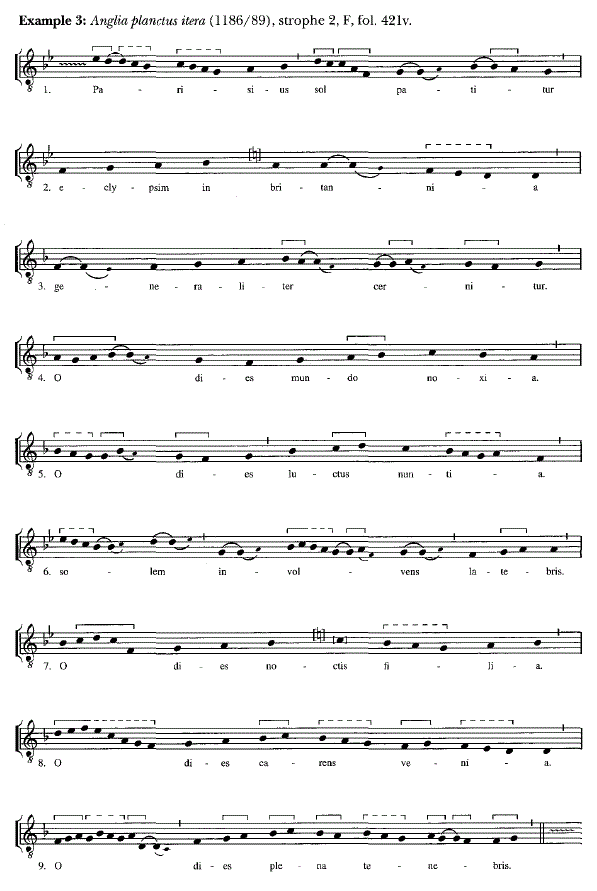
http://teca.bmlonline.it/ImageViewer/servlet/ImageViewer?idr=TECA0000342136#page/782/mode/1up
In
this example, the strategic placement of short melismas or florid neumes
at the beginning of lines 1, 4-6, and 7-9 splits the stanza into three
tercets, a delineation supported by the interlocking formations of the
strophe's rhyme scheme (aba bbc bbc), its syntax, and the anaphora in
lines 4, 5, and 7-9 (the exclamation "0 dies"). By 1189 and
thereafter, caudae are the rule in datable monophonic conductus. The sole
exceptions occur only in Philip the Chancellor's trouvere contrafact
Pater sancte (1198), in his conductus prosulas, and in one of the very
latest one-part pieces, Aurelianis civitas (from 1236 and probably
also his work), whose unusually spare, syllabic setting at this late date
makes one wonder whether it might be a prosula as
well.51
この例では、第1,4〜6、7〜9行の最初の短いメリスマまたはfloridなネウマの戦略的な置かれた状態が音節を、三行連句、詩句の押韻スキーム(aba
bbc bbc)の連結情報でサポートされた描写、その構文、第4,5、7〜9行のanaphora(行頭反復 "0
dies"の繰り返し)に分けている。1189年までに、それゆえ、caudaはdatable monophonic
conductusの約束事となった。唯一の例外はかなり後の単声作品の1つである1236年以後の Philip the Chancellorの
trouvere contrafact Pater
sancteであり、その通常ではないような節約的な、シラビックな設定は、それが同じくprolusaかもしれないという疑問を抱かせることとなった。
Several
of the caudae among the datable monophonic conductus exhibit polished
musical forms and elegant melodic organization. Like their polyphonic
counterparts, they too seem to have shared at least partially in the new
formative aesthetics that are readily visible in the organa of
Perotinus.52 Some of the more ambitious specimens have been included in
the following illustrations. For instance, in example 4, which
features two caudae in conductus from 1190-1192 and 1223 respectively, a
pair of related phrases carves out a melismatic couplet.
The two
ordines in each part of this example begin with closely related
gestures, but finish with cadences that are strongly contrasted through
their use of open and close endings. Other specimens present short
motives in melodic sequence, as in example 5, but perhaps the lengthiest
and most ambitious of all the datable monophonic caudae is the one that
ends the 1198 lament Iherusalem Iherusalem, presented as example 6.
The design of this elegant melisma seems almost to resemble a "textless"
cantio form in its AA'BB'C structure, except that the correspondence here
between the opening sequential gestures is upset somewhat by the strokes
of division that separate the two phrases into uneven
components.
datable monophonic
conductusにあるいくつかのcaudaは、洗練された音楽形式とエレガントな音楽構造を示す。ポリフォニーの相手と同様、それらはペロタンのオルガヌムに明らかに見られるような新しい美学が少なくとも部分的には共有されているように見える。より野心的な作品は以下のような例示を含んでいる。たとえばexample4に見られるような1190‐1192年からのconductusと1223年のconductusの二つそれぞれのcaudaは、関連したフレーズのペアであり、その中にメリスマ的coupletを刻み込んでいる。
この例のそれぞれのパートの二つのordineは、非常に関連した所作とともに始まる。しかし、非常に強いコントラストのあるカデンツとともに終了する。他の例には、
example 5のように、旋律の流れの中で、短いモティーフが存在している。しかし、おそらくは、すべてのdatable monophonic
caudaeのうちでもっとも長くもっとも野心的なものは、1198年の lament Iherusalem
Iherusalemであろう(example
6)。このエレガントなメリスマのデザインは、AA'BB'C構造の"歌詞を持たない”cantio形式に非常によく似ているように見える。オープニングの音の流れの振る舞いにおける対応が幾分、二つのフレーズを不均等な構成に分けるstrokeによってひっくり返されることを除けば。
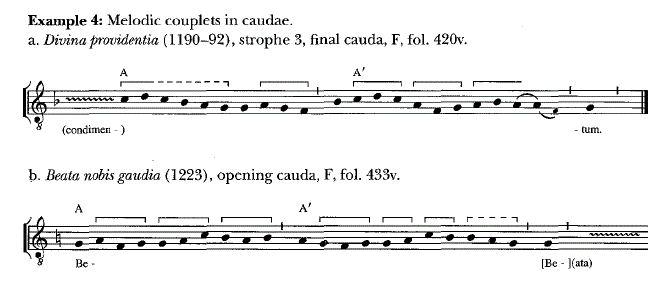

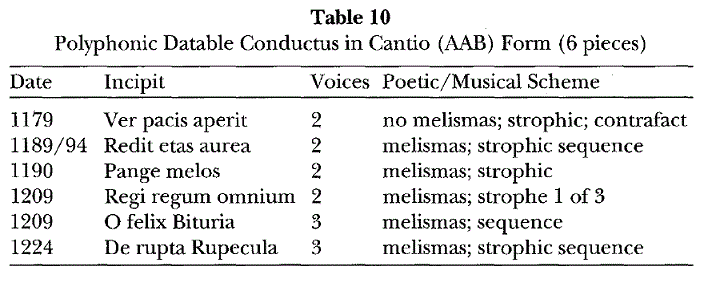
Melismas such as those presented in examples 4-6 are the
exception rather than the rule, but it may be worthwhile to notice that
all of them stem from the 1190s or later, at the same time it is
hypothesized that Perotinus may first have surfaced in Paris (Wright 1989:
293-94). More typically, the bulk of the caudae that appear throughout the monophonic datable corpus
are neither as lengthy, as complex, nor as
adventurous as most of their polyphonic counterparts.
Interestingly, several of them present a recurring figure, especially
frequent at cadential points (compare the boxed phrases in example 7). The
close identity of this gesture among the various pieces as well as its
pitch content easily recall a particular reiterated formula from the body
of organum duplum.53 If more expressions like this one should be
identified, they would suggest that melodic, rhythmic, and
compositional relationships between Leoninian organa and monophonic
conductus are not as diverse as previously assumed.
54
examples
4〜6で示されたようなメリスマは、むしろ、約束事の例外である。しかし、それらのすべてが1190年代あるいはそれ以降に由来することに気付くことには価値があるかもしれない。同時期に、ペロタンがパリで活躍していたはずだからである。さらに典型的なことには、モノフォニックなdatableな体系を通して明らかになったcaudaの莫大な数は、ポリフォニー作品と比較して、長くもなく、複雑でもなく、冒険的でもない、ということである。
興味深いことに、こうした作品は、「繰り返し音型」を有している(compare the boxed phrases in example 7)。特に、cadential pointsにおいて。さまざまな作品間のこうしたよく似た同一性は、音高と同様、organum duplumの形態における特殊な繰り返し音型を思い起こさせる。このような表現が増えれば、レオナンのオルガヌムとモノフォニーconductusの間のメロディ、リズム、作曲の関係はこれまで考えられたほど多様ではなかった(レオナンのオルガヌムにも、こうした繰り返し音型はしばしば見られる)ことを示しているという事実を知るべきである。
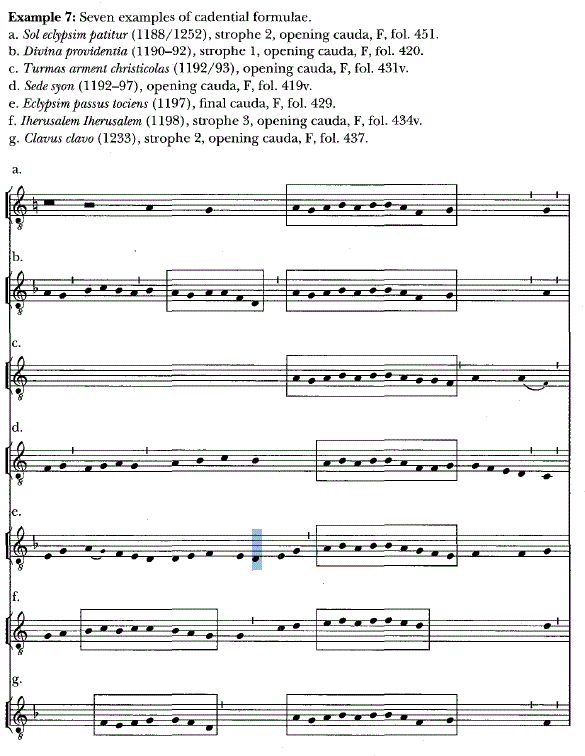
Given the contemporaneous developments in polyphony, the lack of strong rhythmic profiles in the notation of many of the monophonic caudae is perhaps startling. Very few melismas within the monophonic datable repertory appear to suggest a sure rhythmic rendering.
The majority of these tend either to be very short, comprising only two
or three measures in modern transcription, or else they restrict their
rhythmic indications only to the opening gestures of the phrase.
Three of the five brief specimens given in example 8 begin with chains
of ligatures that imply the rhythmic values associated with either the
first or third rhythmic modes. Shortly after these melismas begin, though,
the phrases quickly disintegrate into less obvious readings along the lines of organum purum.
Again, it should be emphasized that all of
these examples hail from the last decade of the twelfth century at the
earliest, which suggests that it was not until this later period that
conductus composers began to incorporate some of the rhythmic facets of
polyphony into their monophonic
works.
もしもポリフォニーにおいて同時的発展があったならば、多くのmonophonic caudaeの記譜において、強いリズム的なプロファイルはなくなっていっただろう。モノフォニックなdatableレパートリーにおけるメリスマのほとんどは、しっかりとしたリズム表現をしないように見える。
こうした(モノフォニックなdatableレパートリーにおけるメリスマの)傾向の多数は、非常に短く、またリズムの使いようを、フレーズのオープニングの振る舞いに限定している。
example 8で示されている5例のうちの3つは、連結符のつながりで始まっている。これらの連結符は、第1、3リズムモードと関連して、リズムの長さを示している。こうしたメリスマが始まるとすぐに、フレーズは、organum purumに沿ってのよりあいまいな譜読みの中で、すぐに崩壊してしまう。
再度、これらすべての譜例が、早くとも、12世紀の最後の10年間からものであることが理解されよう。それはすなわち、conductusの作曲者がモノフォニー作品に対して、ポリフォニーのリズム局面のいくつかと共同し始めたのがこの時期であったことを示している。
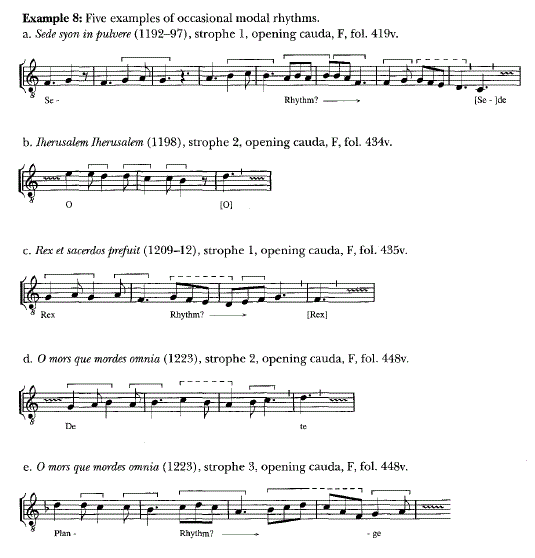
However, a few such caudae are more exceptional. In three instances, melismas appear that are more consistent in their implications of modal rhythms and that also exhibit a scheme of antecedent and consequent phrase pairing that commonly surfaces in the caudae of the polyphonic corpus and in the copula sections of Notre Dame organa (see ex. 9).
It is well worth noticing that not only do all the "modal" caudae in example 9 hail from well after 1200, but all their texts are by Philip the Chancellor. They consequently present the strong possibility that their music may have been written - or at least strongly influenced - by the hand of Perotinus.55
しかしながら、いくつかのcaudaはより例外的である。上記の3例においては、メリスマはモードリズムを含みながらより一貫的に存在し、先行しそして連続した、2声作品のcaudaに、そしてノートルダムオルガヌムの連結部位に共通して現れるフレーズのペアのスキームを見せている。
例9のすべての「モード的な」caudaeが1200年以降に発生しただけでなく、、あらゆるそれらのテキストがPhilip the Chancellorに拠っていたことは、注目すべきことである。こうした音楽がペロタンの手によって書かれた―少なくとも強く影響を受けた―可能性は強く存在している。
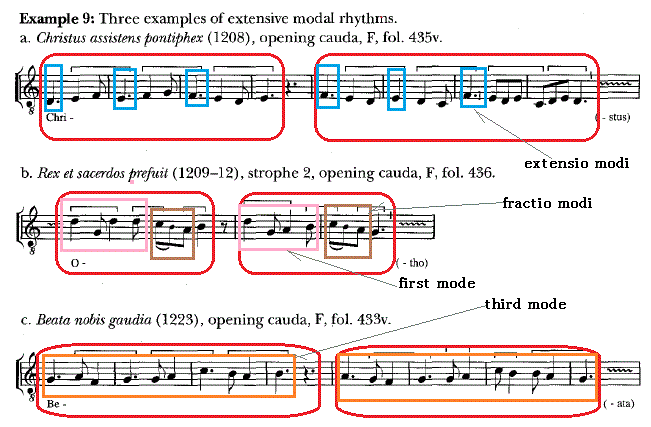
Even though the excerpts presented in example 9 offer evidence of an occasional
foray into rhythmic precision, they remain anomalous. Caudae in later monophonic
conductus tend to maintain the rhythmic ambiguity of earlier specimens.
All of the observations of musical style offered here imply that the monophonic conductus repertory is essentially a more rhythmically fluid genre when compared to the polyphonic. Some notable support for this view is presented by the recent trend in the musicological literature that sees the one-part conductus as a species that participated little, if at all, in the development of rhythm that is so closely linked to the polyphony of the Notre Dame school. 56
example
9に示されている抜粋は、精度の高い(モード)リズムに対して時折攻め込むようになっているが、それらは、変則として残ることになる。より後のモノフォニックconductusのcaudaは、より以前の作品よりも、リズム的にあいまいであることが多い。
これまで行われた音楽形式のあらゆる考察は、モノフォニックなconductusのレパートリーが、ポリフォニーと比較して、本質的にはリズム的には流動的な分野であることを示している。こうした見方に対する支持は、単声conductusが、ノートルダム楽派のポリフォニーに密接に結びついているリズムの発展にはほとんど参加していないことを確認している最近の音楽学的傾向において見られる。
|









